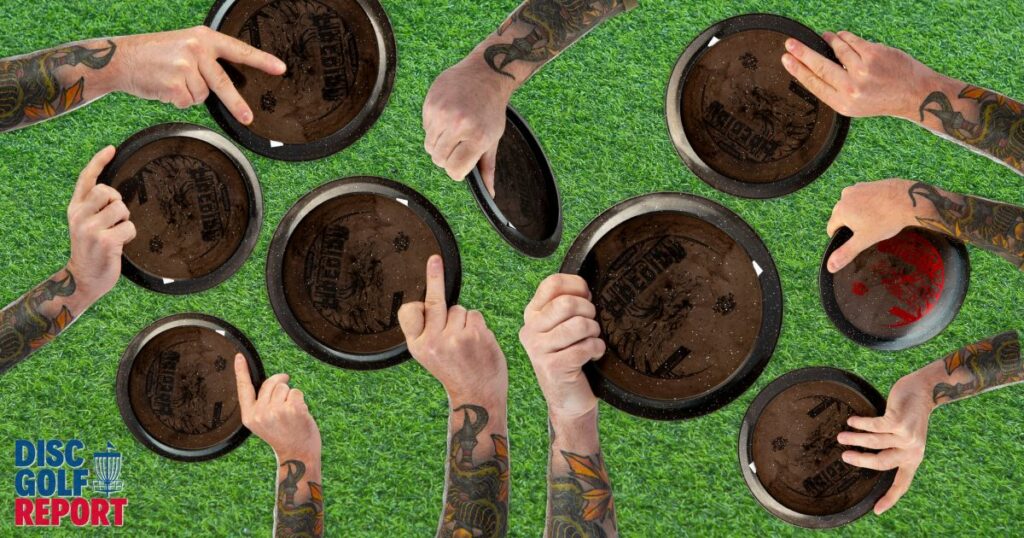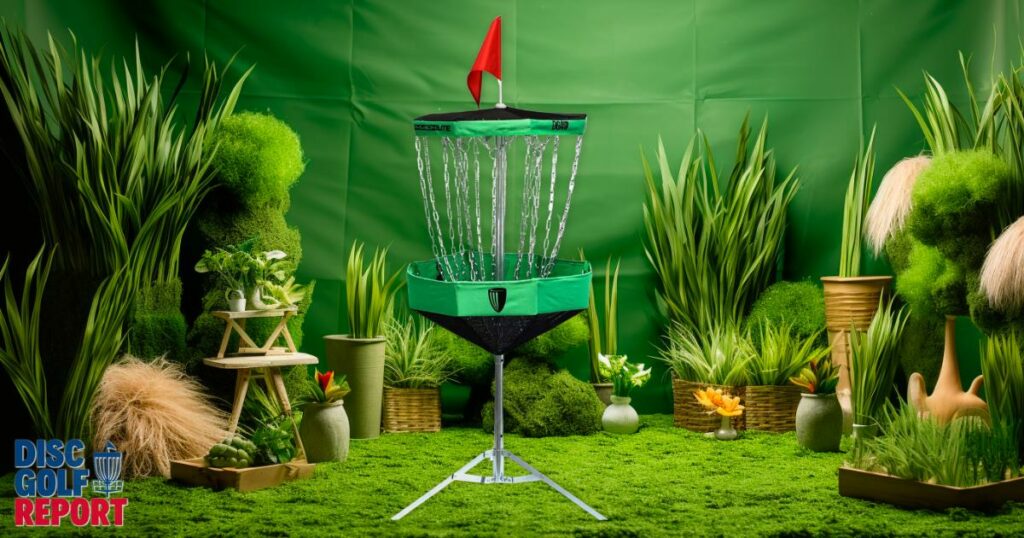Welcome to the world of disc golf, a sport where precision, power, and finesse come together in the palm of your hand – quite literally.
The grip you choose while handling a disc can make a monumental difference in your game. Whether you’re a seasoned player aiming for that perfect anhyzer or a newcomer learning how to drive with a hyzer flip, understanding the nuances of disc golf grips is essential.
In disc golf, just like in traditional golf, the way you hold your equipment is foundational to your performance. But unlike the rigid clubs of ball golf, disc golf offers a variety of discs – each with its own unique flight characteristics and grip requirements. From the way you curl your fingers around the rim for a power drive to the delicate balance required for a controlled upshot, each grip has its own story.
In this comprehensive guide, we’ll dive deep into the heart of disc golf grips. We’ll explore the various types of grips used for different shots, from backhand to forehand, and even those specialty throws that can save you strokes in tricky situations. We’ll discuss the pros and cons of each grip, how to choose the right one for your playing style, and some common mistakes to avoid.
So, grab your favorite driver, mid-range, or putter, and let’s get a grip on disc golf!
The Basics of Disc Golf Grips
In the world of disc golf, your grip is the critical bridge between you and your disc. It’s not just about holding the disc; it’s about mastering how it flies, spins, and lands. Let’s break down the essentials.
Understanding Grip Dynamics
A successful grip in disc golf is all about finding the sweet spot between comfort and control. It should feel as natural as a handshake – firm yet relaxed.
This balance is crucial because the pressure you exert influences both the disc’s stability in flight and your ability to release it smoothly. Too loose, and you risk an unpredictable release; too tight, and you might stifle the disc’s natural flight path.
The way you grip the disc also directly affects your throw dynamics. For instance, the grip angle plays a pivotal role in determining the release angle – essential for executing hyzers, anhyzers, or straight shots with precision. Moreover, your grip impacts the spin (RPM) and speed imparted to the disc.
A nuanced understanding of these dynamics allows you to adjust your throws according to the distance, wind conditions, and the type of disc in play.
Hand Positioning
Every detail matters when it comes to hand positioning. The placement of your fingers along the rim and underside of the disc can drastically change the disc’s stability and power. Similarly, the thumb’s positioning, providing balance and counter-pressure, is a subtle yet powerful element that can make or break a throw.
Grip Adaptation
A key characteristic of a skilled disc golfer is the ability to adapt their grip to different discs and throwing scenarios. Whether you’re driving down a fairway or approaching the basket, being flexible and open to experimenting with various grips can significantly enhance your game. This adaptability not only improves your current skills but also opens up new avenues in your throwing repertoire.
Read Next: Here’s The Best Disc Golf YouTube Channels
With these basics in mind, you’re now ready to delve into the various types of grips and their specific applications in the game.
Types of Grips
In disc golf, the diversity of grips is as vast as the courses you play on. Each grip offers unique advantages and challenges, catering to different throwing styles and scenarios. Let’s explore the most commonly used grips in disc golf.
Disc Golf Backhand Grip
The backhand grip is the most popular and versatile grip in disc golf, ideal for achieving distance and accuracy.
Power Grip

This is the go-to grip for maximum distance. All four fingers are tucked tightly under the disc’s rim, with the thumb on top to provide control. It’s ideal for drives where you need to cover a lot of ground.
Fan Grip

Used primarily for mid-range shots and putts, the disc golf fan grip offers more control. Fingers are spread out or ‘fanned’ under the disc, with the thumb on top, allowing for precise throws.
Modified Fan Grip

A variation of the fan grip, it combines elements of both the power and fan grips, offering a balance of distance and control. This grip is often used for approach shots.
Two-Finger and Three-Finger Grips
These grips involve using only two or three fingers under the disc. They offer more control for certain players, especially in tight or technical situations.
Forehand Grips
The forehand, or sidearm, grip is essential for shots that require a different flight path or when obstacles prevent a backhand throw.
Two Finger Stacked Grip
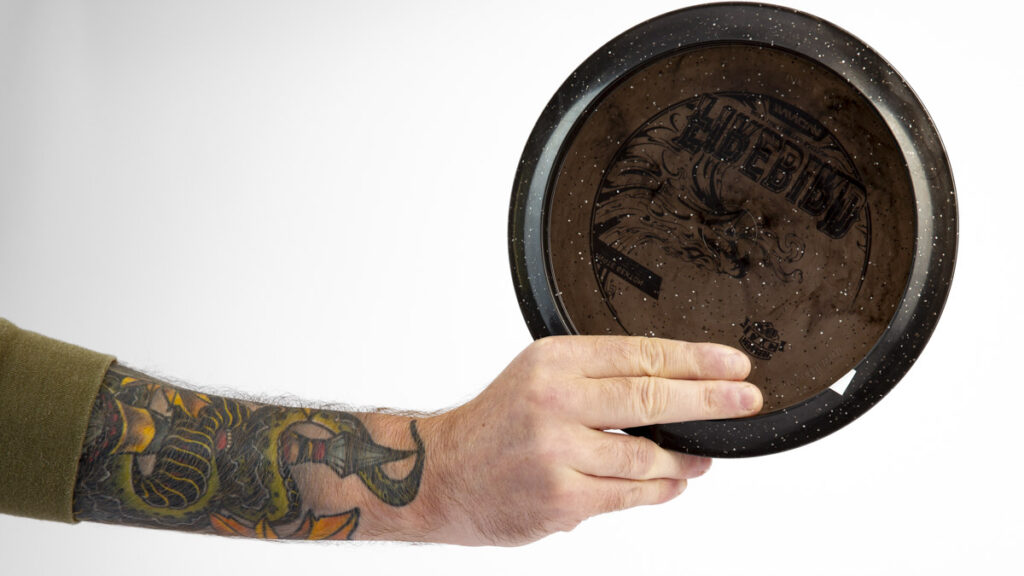
This grip involves stacking two fingers under the disc, with the thumb on top. It’s a powerful grip for forehand drives.
Single Finger Grip
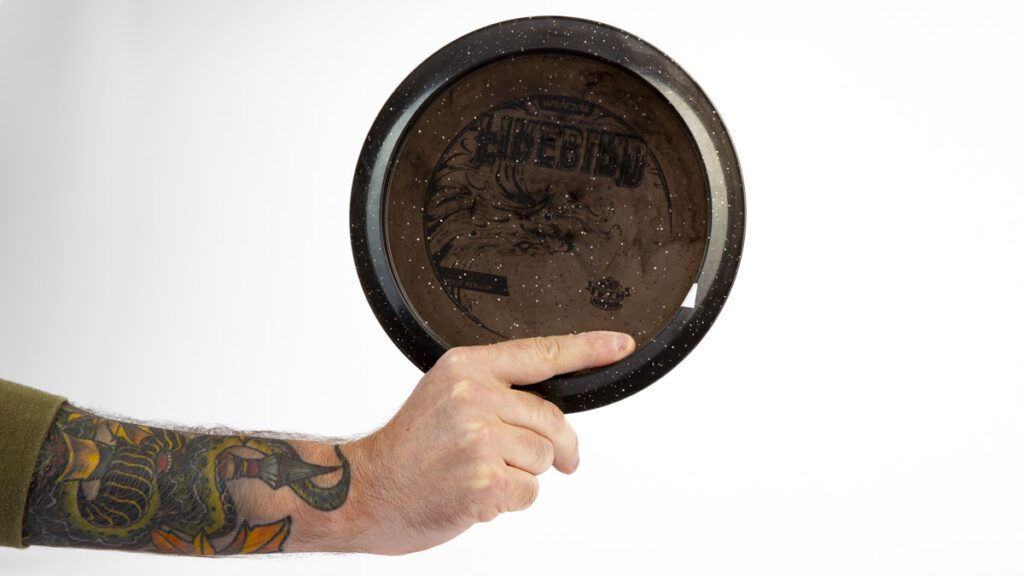
Some players prefer using only one finger under the disc for more control during forehand shots.
Split Finger Grip

I promise, I’m not giving you the bird.
This is the split finger forehand disc golf grip, which some players find gives them more control with their pointer finger.
Forehand Fan Grip
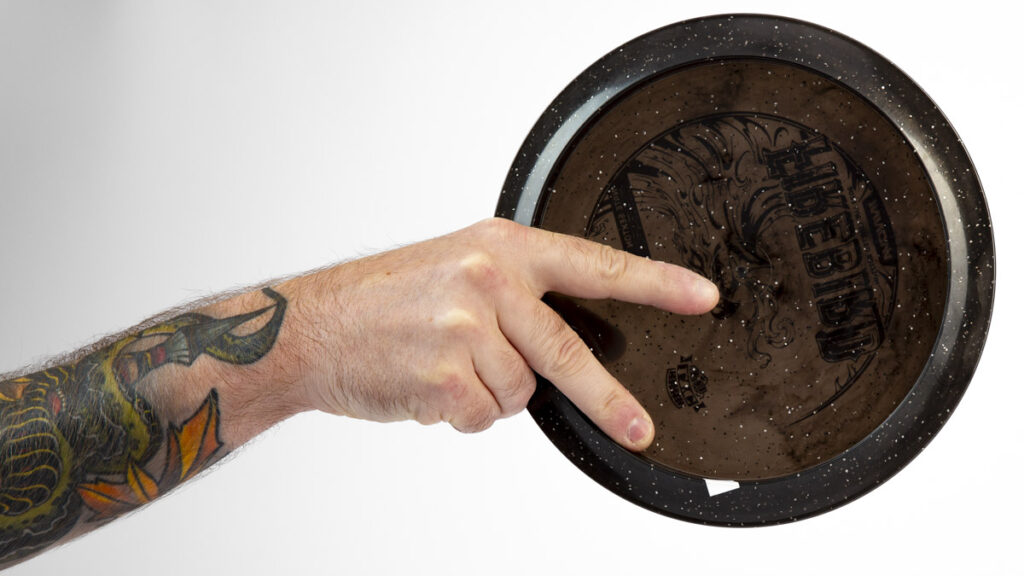
Personally, this is my least favorite of the forehand grips. I find that separating the two fingers on the bottom of the disc gives me much less control/accuracy and even less power. But hey, it could be your thing.
Utility/Overhand Grips
These specialty grips are used for overhand throws like thumbers and tomahawks, offering unique flight paths and problem-solving options on the course.
Thumber
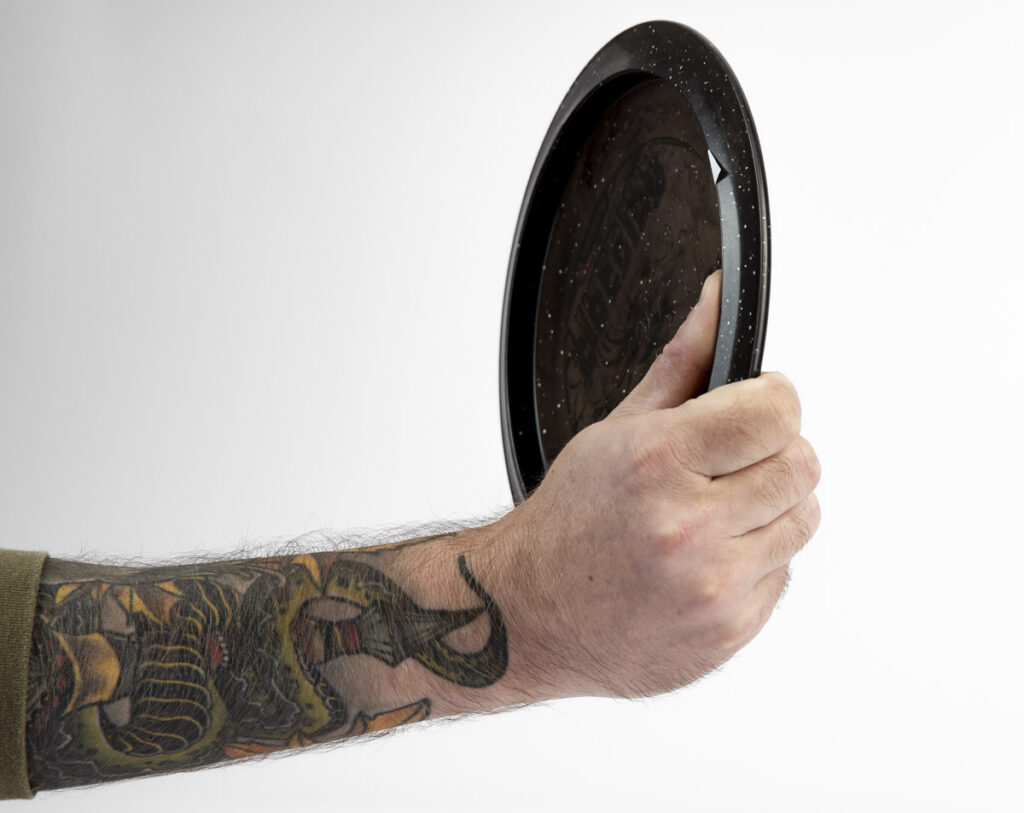
Named because the thumb is placed inside the rim, the thumber grip allows for a unique overhand throw that can navigate over obstacles.
Tomahawk
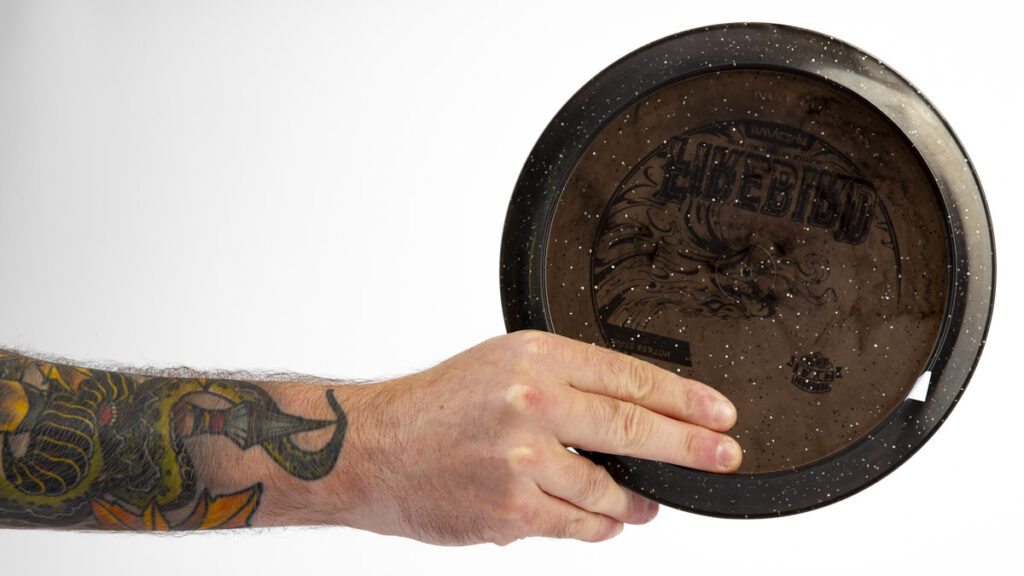
Similar to the thumber but with a different hand orientation, the tomahawk grip is another option for clearing obstacles and achieving specific flight paths.
Each disc golf grip type brings its own flavor to the game, and mastering them can elevate your disc golf skills to new heights. Experiment with these grips to find what works best for you and your playing style.
Choosing the Right Grip for Your Style
Selecting the right grip in disc golf isn’t just about copying what works for others; it’s about finding what works best for you. Your choice of grip should complement your throwing style, the disc you’re using, and the shot you’re attempting. Here’s how to align your grip with your playing style.
Assessing Your Play Style
- Power Players: If your game is centered around powerful drives, the Power Grip might be your ally. It’s designed for distance and speed, perfect for players who prioritize covering ground.
- Control-Oriented Players: If precision and accuracy are your hallmarks, consider grips like the Fan Grip or the Modified Fan Grip. These allow for more nuanced control, especially useful in mid-range shots and putts.
- Adaptable Players: For those who switch between power and precision, learning multiple grips and knowing when to use them is key. Being versatile with your grips allows you to adapt to various course challenges.
Read Next: Discs vs Frisbees: What’s The Difference
Considering Disc Types
- Drivers: Heavier and faster discs like drivers generally pair well with stronger grips like the Power Grip, especially when maximum distance is the goal.
- Mid-Ranges and Putters: Lighter discs, like mid-ranges and putters, often benefit from grips that offer more control and finesse, like the Fan Grip.
Experimentation and Practice
- Trial and Error: Don’t be afraid to experiment with different grips. Practice with various grips can reveal surprising insights about your play style and preferences. Get a disc golf bag that can hold a lot of discs so you can start doing fieldwork.
- Feedback and Adjustment: Pay attention to how each grip affects your throw. If a grip feels uncomfortable or the disc isn’t flying as intended, don’t hesitate to make adjustments.
Listening to Your Body
- Comfort and Injury Prevention: Your grip should not only be effective but also comfortable. An unnatural or strained grip can lead to injuries over time, so it’s crucial to listen to your body.
- Hand Size and Strength: Consider your hand size and strength when choosing a grip. What works for someone with larger hands may not be suitable for someone with smaller hands.
The right grip is a personal choice that depends on various factors, including your playing style, the discs you use, and physical comfort. Take the time to understand and experiment with different grips to find the one that elevates your game.
How to Improve Your Grip
Improving your grip in disc golf is not just about selecting the right type but also about refining and perfecting it over time. Here are some tips to help enhance your grip for better performance and consistency.
Practice Makes Perfect
- Regular Practice: The best way to improve your grip is through consistent practice. Regular throwing sessions will help you develop muscle memory, making your chosen grip feel more natural over time.
- Focused Drills: Incorporate specific drills that focus on grip strength and control. For example, practice throwing with different grip styles to see how they affect the disc’s flight.
- Cross Training: Disc golf isn’t the only sport that will strengthen your grip. Many forms of paddle/racquet sports, combat sports (like no gi jiu jitsu), and ball golf will all help strengthen your grip as well.
Learn More: The Best Innova Drivers For Distance
Developing Hand Strength and Dexterity
- Hand Strengthening Exercises: Strong hands and fingers provide better control and power in your throws. Exercises like squeezing a stress ball or using grip strengtheners can be beneficial.
- Dexterity Drills: Improve your finger dexterity with exercises like playing a musical instrument or typing drills. Better dexterity allows for more precise grip adjustments.
Learning from Others
- Watch and Learn: Observe how experienced players grip their discs. You can learn a lot by watching others, especially during tournaments or in instructional videos.
- Seek Feedback: Don’t hesitate to ask for feedback from more experienced players or coaches. They can provide valuable insights into how you can improve your grip technique.
Adjusting for Different Conditions
- Weather Adaptations: Your grip might need to change in different weather conditions. For example, a wet disc might require a firmer grip, while a dry, hot day might allow for a more relaxed hold.
- Disc Wear and Tear: Be aware of how the wear and tear on your discs can affect your grip. A well-worn disc might require a slightly different grip compared to a brand-new one.
Improving your grip is a journey that involves practice, strength building, learning from others, and adapting to different conditions. As you refine your grip, you’ll likely notice improvements in your overall game, from increased distance to enhanced accuracy and control.
Read Next: Best Portable Disc Golf Baskets
Common Mistakes and How to Avoid Them
Even the most experienced disc golfers can fall into the trap of common grip mistakes. Being aware of these errors and knowing how to avoid them is crucial for improving your game.
Over-Gripping
- The Mistake: Holding the disc too tightly, often due to a desire for more control or power. This can lead to reduced flexibility and a less natural release, affecting accuracy and distance.
- The Fix: Practice holding the disc with a firm yet relaxed grip. Aim for a pressure that’s secure enough to maintain control but not so tight that it hinders the disc’s natural release.
Under-Gripping
- The Mistake: Gripping the disc too loosely, which can lead to inconsistent releases and reduced control over the disc’s flight.
- The Fix: Increase your grip pressure incrementally until you find a balance that offers both control and a comfortable release.
Read Next: I Reviewed 8 Disc Golf Retrievers
Inconsistent Finger Placement
- The Mistake: Inconsistent placement of fingers on the disc, leading to unpredictable throws.
- The Fix: Pay attention to where your fingers are placed and strive for consistency in every throw. Practice makes this second nature.
Ignoring Hand Size and Shape
- The Mistake: Using a grip that doesn’t suit your hand size or shape, which can lead to discomfort and ineffective throws.
- The Fix: Experiment with different grips to find one that feels natural for your hand. Remember, what works for others may not work for you.
Not Adjusting for Different Disc Types
- The Mistake: Using the same grip for every type of disc, regardless of its purpose and design.
- The Fix: Adjust your grip based on the disc type. For instance, a driver might require a firmer grip compared to a putter.
Avoiding these common mistakes will not only improve your grip but also enhance your overall performance on the course. Each throw is an opportunity to refine your technique and develop a more effective and comfortable grip.
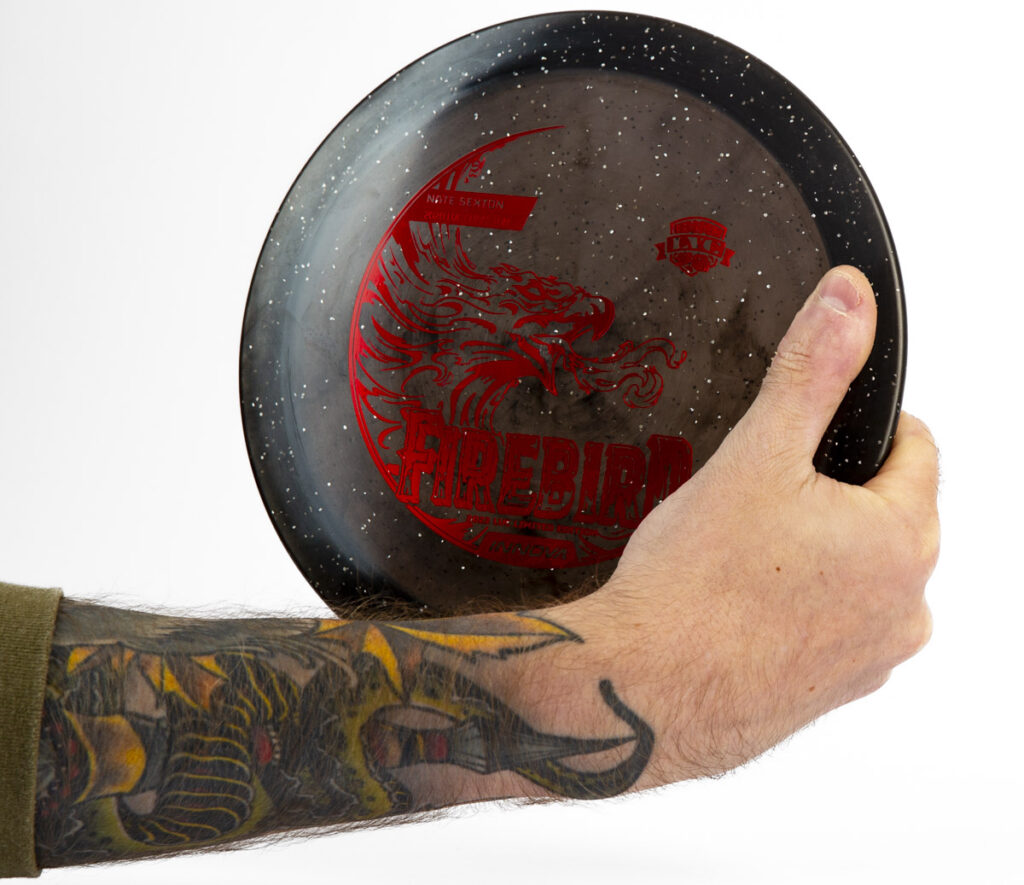
Advanced Grip Techniques
For the seasoned disc golfer looking to take their game to the next level, mastering advanced grip techniques can be a game-changer. These techniques often involve subtle adjustments or entirely different ways of holding the disc, each with their own strategic advantages.
Hybrid Grips
- Overview: Hybrid grips combine elements of basic grips to suit specific throwing styles or conditions. They offer a middle ground between control and power.
- Application: Use hybrid grips when you need more control than a power grip offers but more distance than a fan grip. They are particularly useful in windy conditions or for technical shots.
Grip Modifications for Specialty Shots
- Overview: Some shots, like rollers or skip shots, may require modifications to the standard grips.
- Application: For a roller, you might adjust your grip to release the disc with more angle, while a skip shot might require a firmer grip to maintain the disc’s integrity upon impact.
Adapting Grips for Disc Wear
- Overview: As discs wear, their flight characteristics change. Adapting your grip to these changes can maintain performance levels.
- Application: For a worn-in disc, you might opt for a tighter grip to compensate for the reduced stability, ensuring consistent release and flight.
Grip Adjustments for Extreme Distances
- Overview: Throwing for extreme distances, whether for maximum reach or precision approaches, often requires slight grip adjustments.
- Application: For maximum distance, you might tighten your power grip slightly, whereas for precision approaches, a more relaxed fan grip could be more effective.
Using Grip to Influence Disc Stability
- Overview: Your grip can influence a disc’s stability, affecting how much it turns or fades.
- Application: For more turn, you might relax your grip slightly, allowing the disc to rotate more. For more fade, a firmer grip can help maintain the disc’s stability longer.
These advanced techniques require practice and a deep understanding of how different grips affect the disc’s flight. Experiment with these techniques to discover new ways to tackle challenging shots and refine your overall game.
Personal Experience and Recommendations
Drawing from years of experience and countless rounds of disc golf, I’ve gathered some personal insights and recommendations that might help you refine your grip and, consequently, your game.
Embrace Experimentation
- My Approach: Over the years, I’ve learned that there’s no one-size-fits-all when it comes to grips. What worked wonders for me on one course might not on another. I’ve experimented with various grips in different situations – from calm, open fields to windy, wooded courses.
- Recommendation: Don’t shy away from trying new grips. What feels odd at first might just be the key to unlocking a new level of control or power in your throws.
Adaptability is Key
- My Observations: Adaptability has been crucial in my disc golf journey. I’ve switched between grips based on the disc type, weather conditions, and the specific challenges of each hole.
- Recommendation: Be flexible with your grip choices. A power grip might be great for your driver, but a fan grip could work better for your putter.
Personal Favorites
- Power Grip for Distance: When I need to cover a lot of ground, the power grip is my go-to. It gives me the maximum distance, especially with high-speed drivers.
- Fan Grip for Putting: For putts and gentle upshots, the fan grip offers me the control and precision I need.
The Importance of Comfort
- My Experience: Comfort has always been a priority. I’ve found that an uncomfortable grip not only affects my throw but can lead to strain over time.
- Recommendation: Choose a grip that feels comfortable and natural in your hand. If a grip causes discomfort, it’s worth reevaluating.
Continuous Learning
- My Philosophy: Disc golf is a journey of continuous learning and improvement. I’ve evolved my grips over time, learning from both successes and failures.
- Recommendation: Stay open to learning and evolving your grip technique. Watch others, seek feedback, and always be willing to refine your approach.
My experience has taught me the importance of experimentation, adaptability, comfort, and continuous learning in mastering disc golf grips. Try out different grips and find what works best for you, keeping in mind that your grip might evolve as you grow in the sport.
Mastering disc golf grips is a blend of art and science. We’ve explored various grip types, from the powerful backhand power grip to the precise fan grip, and delved into advanced techniques for seasoned players.
Remember, the right grip depends on your playing style, the disc type, and personal comfort. Experimentation, adaptability, and continuous learning are key to finding and refining your ideal grip. Embrace the journey of mastering your grip, and you’ll see a significant impact on your overall game.
Now go throw some discs!
